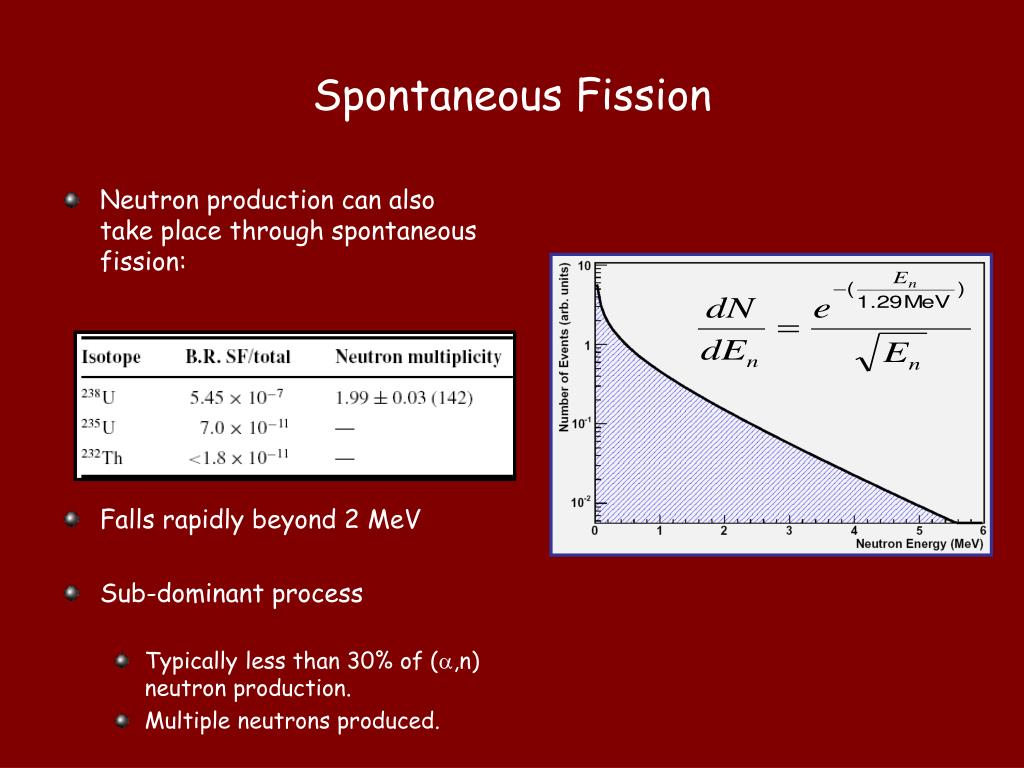

This value agrees with value (0.183 ± 0.007) × 10 −3 b within uncertainty presented by W. The SACS in the 252Cf spontaneous fission neutron field for the 63Cu(n,2n) 62Cu reaction was determined as equal to (0.1763 ± 0.0077 mb). SACS was inferred from the experimental reaction rate. Fortunately, contributions to the annihilation peak from these isotopes can be distinguished due to the very different half-lives. The SACS in the 252Cf spectrum was chosen as a validation tool since 252Cf is the only standard neutron field and 62Cu isotope is not easy to measure by gamma spectroscopy since the gamma line of interest is an annihilation peak, which is also produced by 64Cu isotope. This paper presents the measurement of the spectrum-averaged cross section (SACS) of 63Cu(n,2n) 62Cu reaction in 252Cf spontaneous fission neutron spectrum.
#CF 252 SPONTANEOUS FISSION RATE FULL#
Determine the identity of that isotope and write out the spontaneous fission rection, using full isotopic notation.ġ) Write just the left-hand side of the equation: Here is a search if you are interested.Įxample #6: An isotope of californium-252 undergoes spontaneous fission, producing cesium-135, three neutrons and one other isotope. I could not find the mass distribution curve for Fm-256 online, but I did find references to research on that topic.
#CF 252 SPONTANEOUS FISSION RATE PLUS#
In the case of Cf-252, the two mass numbers plus any neutrons released will always add up to 252, the mass number of the californium. There are two peaks, one for the heavier fragment and one for the lighter. You will be looking at a mass distribution curve for the SF of Cf-252. Go here after reading the rest of the paragraph. How do you know what decay products are produced? A very good question! Nothing starts the SF from outside, the decay originates from internal imbalances.Įnergy is also produced when a nuclide undergoes SF, this is typically not shown in the equation. Note that the atomic number is the same on both sides as well as the mass number totalling up to be the same on each side. In the region near 230, SF can be quite rare while in the upper regions (a 254, for example), SF is usually the most common form of decay.

A percentage of the time, they decay by spontaneous fission. Some by beta decay, some by positron, etc. These nuclei are unstable and decay by different forms of radioactive decay. Spontaneous fission (SF) happens in heavier elements, those with atomic numbers greater than 89 and mass numbers of about 230 and above. ChemTeam: Writing Spontaneous Fission Equations Writing Spontaneous Fission Decay Equations Alpha Decay & Beta Decay Neutron Emission & Capture Positron Decay & EC Proton Emission & Capture Gamma Decay Radioactivity MenuĪ Brief Tutorial About Writing Nuclear Symbols


 0 kommentar(er)
0 kommentar(er)
